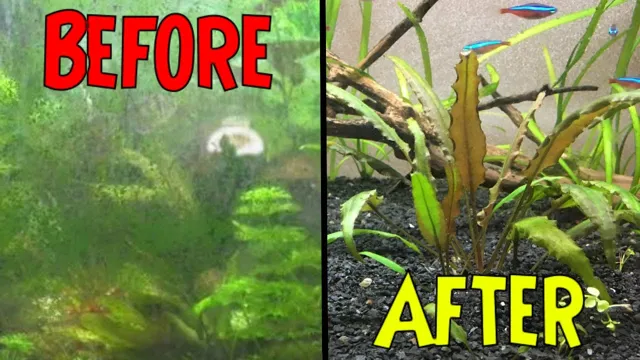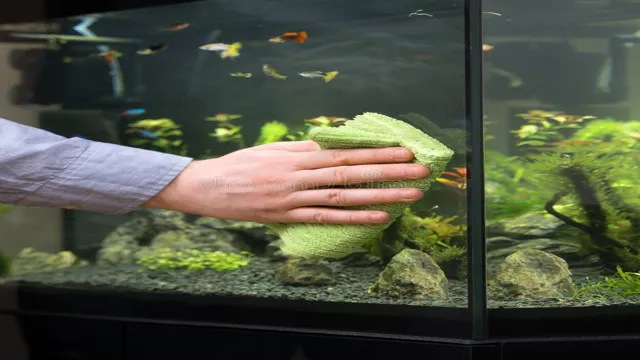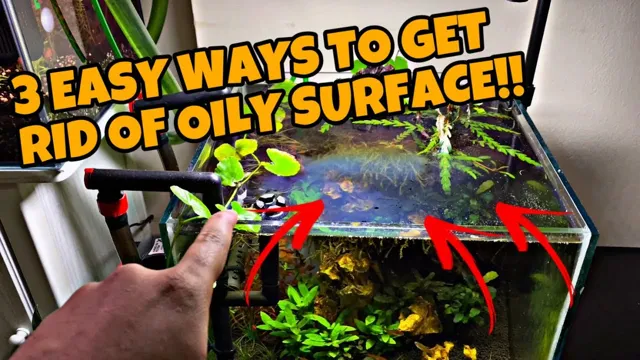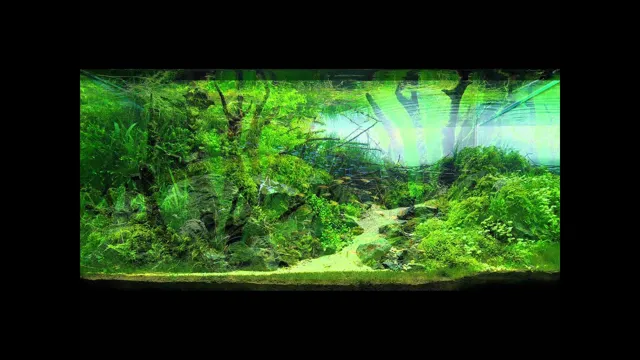Are you struggling with unsightly algae growth on your aquarium live plants? It’s a common problem for many aquarium enthusiasts, and it can be tricky to know how to tackle it properly. Algae can quickly take over your tank and make it look dirty and unappealing. Not to mention, it can harm your plant’s health and growth.
But don’t worry – with a few simple steps, you can kill algae on your aquarium live plants and get your tank looking clean and clear again. In this blog post, we’ll cover effective methods for removing algae, as well as preventative measures to keep it from coming back. So, let’s dive in!
Identify the Type of Algae
If you’re looking to get rid of algae on your aquarium live plants, it’s important to first identify the type of algae you’re dealing with. There are several different types, including green algae, brown algae, blue-green algae, and hair algae, among others. Each of these types has its own set of characteristics, so it’s important to learn how to recognize them in order to effectively treat them.
For example, green algae are typically the most common type and can be easily recognized by their bright green color and slime-like appearance. To get rid of this type of algae, you may need to adjust your lighting or nutrient levels in the aquarium. Brown algae, on the other hand, are often caused by high levels of silicates in the water and can be treated by adding a silicate-absorbing resin to the filter.
By identifying and targeting the specific type of algae in your aquarium, you can effectively get rid of it and ensure that your live plants stay healthy and vibrant.
Black Beard Algae
Black Beard Algae If you’ve noticed a thick, dark growth on your aquarium decorations and plants, you may be dealing with Black Beard Algae. It can be difficult to get rid of, but proper identification is key. Black Beard Algae has a distinctive appearance, resembling dark greenish-black tufts or patches.
It can be mistaken for hair algae, but unlike hair algae, it’s much harder to remove and can quickly take over your tank. When attempting to eradicate it, be sure to avoid using harsh chemicals or bleaches that can harm your fish and plants. Instead, try trimming off affected leaves and reducing lighting and nutrient levels.
Black Beard Algae is often a sign of an imbalance in your aquarium’s ecosystem, so monitoring and adjusting conditions is crucial in preventing a resurgence. By staying vigilant and taking a holistic approach to aquarium maintenance, Black Beard Algae can be kept under control.
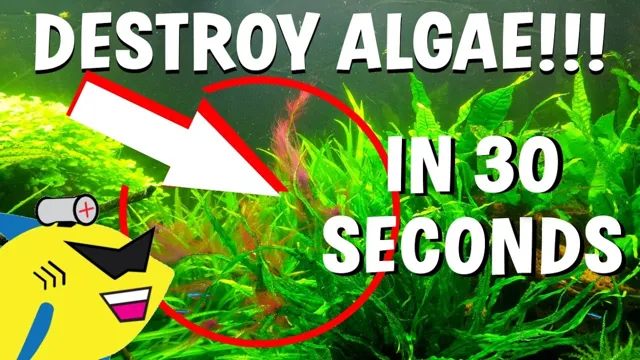
Green Algae
Green algae are a diverse group of aquatic plants that come in many shapes, sizes, and colors. Some species of green algae are unicellular, while others are multicellular and can form complex structures. Identifying the type of green algae can be challenging, as there are thousands of species.
One way to identify them is by the color of their chloroplasts. Chloroplasts are organelles found in green algae that contain the green pigment chlorophyll. Chloroplasts can be cup-shaped, plate-shaped, or spiral-shaped, depending on the species.
Another way to identify green algae is by their habitat. Some species of green algae live in freshwater, while others live in saltwater or in damp soil. Green algae can also be distinguished by their method of reproduction.
Some species reproduce asexually through cell division, while others reproduce sexually through the fusion of two cells. By understanding the characteristics of different types of green algae, scientists can better understand their ecological importance and potential uses in biotechnology.
Blue-Green Algae
Blue-green algae is a type of bacteria that can be found in freshwater lakes, streams, and ponds. While it’s called “blue-green” algae, it can actually appear in a variety of colors, including green, blue, and red. Identifying the type of algae is important because not all algae is harmful. (See Also: How to Put Aquarium Air Pump: A Beginner’s Guide to Setting Up Air Pump in Your Fish Tank)
Blue-green algae has the potential to produce toxins that can be harmful to humans, pets, and wildlife. If you suspect that you have blue-green algae in your body of water, it’s important to take precautions to protect yourself and your loved ones. One way to do this is by not swimming or swimming near the water where the algae is located.
Another effective way to identify blue-green algae is by looking for signs of algal blooms on the water’s surface. If you notice a distinct green or blue color on the water and the presence of foam-like substances on the shore, it’s likely that you have blue-green algae present. Be sure to contact your local health department or environmental agency for further advice on how to handle the situation.
Remove Algae Manually
When it comes to aquarium live plants, algae can often become an unwelcome guest. One way to minimize its presence is to remove it manually. This can be done through regular maintenance such as scraping the algae off with a clean toothbrush or a dedicated algae scraper.
It’s important to not disturb the live plants too much while doing so. Another option is to introduce algae-eating creatures such as amano shrimp or snails, which can help control the algae growth. However, it’s essential to research the specific needs and compatibility of these creatures with your aquarium before adding them.
Keeping the aquarium’s water clean and well-maintained can also help prevent algae growth. Overall, a combination of manual removal, algae-eating creatures, and proper maintenance can help keep algae at bay and make sure your live plants thrive.
Scrub off with a Brush
Removing algae manually can be a difficult task, but it’s not impossible. Scrubbing off with a brush is one of the most effective methods of manual removal. However, before getting started, it’s essential to determine the type of algae you’re dealing with since some forms may require specific cleaners or treatments.
Once you’ve identified the type of algae, you can choose an appropriate brush, such as a stainless steel or nylon brush, to scrub it off. Be sure to wear gloves and protective eyewear to avoid getting any chemicals on your skin or in your eyes. Begin by spraying the affected area with water to make it easier to work with and then scrub the algae vigorously with the brush.
When scrubbing, work in a circular motion and make sure to cover the entire area thoroughly. Rinse the area well with clean water afterward to remove any loose algae or debris. Regularly monitoring and manually removing algae from your surfaces will keep them clean and healthy for longer, so don’t neglect this important maintenance task!
Use Hydrogen Peroxide
If you’re tired of dealing with algae growth in your water garden or pond, don’t despair! There are ways to remove algae without the use of harsh chemicals. One method is to remove the algae manually. This involves physically removing the algae using a net or by hand.
While this method may take some time and effort, it can be effective in reducing algae growth. Another method is to use hydrogen peroxide. Hydrogen peroxide is a natural oxidizer that can help break down organic materials, including algae.
To use hydrogen peroxide, first, dilute it with water and then apply it to the affected areas. It’s important to note that while hydrogen peroxide is safe for aquatic life in small doses, it should be used with caution and in moderation. With these methods, you can effectively remove algae from your water garden or pond and enjoy crystal clear water.
Reduce Nutrient Levels
One effective method for killing algae in an aquarium with live plants is to reduce the nutrient levels in the water. Algae thrive in environments with high levels of nutrients such as nitrate and phosphate, which are often introduced into the water through excess fish food, decaying plant matter, or tap water. To reduce these levels, you can perform frequent water changes, limit the amount of food you feed your fish, and avoid overstocking the tank.
Additionally, you can add a phosphate removal media to your filter or use a specialized algae control product that targets specific types of algae. It’s important to remember that killing algae is only part of the solution, as re-establishing a healthy balance in your tank will prevent the algae from simply returning. By maintaining proper levels of nutrients and taking a proactive approach to tank maintenance, you can enjoy a thriving aquarium without the hassle of unwanted algae growth. (See Also: How to Make Aquarium Silicone Dry Faster: Tips and Tricks for Quick Drying)
Reduce Light Exposure
Reducing light exposure is crucial for the well-being of our bodies since it can disrupt our sleep-wake cycle or circadian rhythm. Our bodies naturally follow this cycle, but with excessive exposure to artificial light, this affects our ability to fall asleep and stay asleep. When we get too much light at night, melatonin production decreases, which is a hormone that regulates sleep.
In turn, this can lead to restlessness or insomnia. Luckily, there are plenty of ways to reduce light exposure, from installing blackout curtains to using amber glasses that filter out blue light emitted by electronic devices such as laptops and smartphones. By reducing light exposure, we can help to regulate our circadian rhythms and promote better sleep quality.
Reduce Excess Nutrients
Reducing nutrient levels is essential to maintaining a healthy environment, both in your local area and globally. Excess nutrients from agricultural or industrial activities can lead to an overgrowth of algae and other aquatic plants in water systems. This overgrowth can create a condition called eutrophication, which affects water quality and can harm aquatic life.
One way to reduce nutrient levels is by using less fertilizer or applying it only in the right amounts and time of year. It’s important to regulate industrial activity to reduce nutrient runoff. Choosing environmentally friendly products and using them in moderation can also help.
By reducing nutrient levels, we can preserve water quality and protect ecosystems for generations to come.
Add Algae-Eating Fish
Are you struggling with keeping algae under control in your aquarium with live plants? One solution is adding algae-eating fish to your tank. These types of fish, such as Siamese algae eaters or plecos, can be very effective at controlling algae growth. Not only are they a natural solution, but they also add a unique element to your aquarium’s ecosystem.
These fish will enjoy eating any excess algae growing on plant leaves or decorations, which will help keep your aquarium looking clean and healthy. Remember to research the specific type of fish you plan to introduce to ensure they are compatible with your plants and other aquatic organisms. By adding algae-eating fish to your tank, you can provide a natural and effective solution to keep your aquarium looking its best while also improving the overall health of your aquatic environment.
Siamese Algae Eater
If you’re looking to add an algae-eating fish to your aquarium, consider the Siamese Algae Eater. Not only are they efficient at cleaning up algae, but they’re also active and sociable fish that add some liveliness to your tank. These fish are small, growing up to about six inches, and can be kept in groups of at least five.
They’re a hardy species that can adapt to a range of water conditions, making them a good choice for most aquariums. To keep them healthy and happy, be sure to provide them with plenty of hiding places and surfaces to graze on. So if you’re struggling with keeping your tank clean and clear of algae, consider adding some Siamese Algae Eaters to your aquatic ecosystem.
Otocinclus Catfish
Adding an Otocinclus Catfish to your aquarium is a great way to keep your tank clean and healthy. These little algae-eating fish are a popular choice among aquarium enthusiasts because of their ability to control algae growth. Otocinclus Catfish are small but mighty, and can devour algae in no time.
They are a peaceful breed that gets along with almost any other fish and are company for your lonely fish. These little guys are easy to care for and will quickly become a valuable addition to your aquarium. If you are struggling with cleaning algae from your aquarium, consider adding an Otocinclus Catfish to your tank and let them do the hard work for you.
Trust us, you won’t regret it! (See Also: How to Find Coupons to Dallas World Aquarium and Save Money on Your Visit)
Conclusion
In conclusion, defeating algae on aquarium live plants requires a multi-pronged approach. Cutting back on light exposure, ensuring proper nutrient levels, and regular tank maintenance are all crucial steps in the battle. However, even with the best efforts, algae may still persist.
When all else fails, we suggest recruiting some tiny, aquatic vigilantes – algae-eating fish or invertebrates! With their help, your aquarium will be a pristine underwater paradise once more. Happy fish-keeping!”
FAQs
What causes algae growth on live plants in an aquarium?
Algae growth is caused by an excess of nutrients, such as light and nutrients in the water.
What are some natural ways to control algae growth on live plants?
Adding snails, shrimp, or algae-eating fish to the aquarium, reducing lighting exposure, and increasing water changes can help naturally control algae growth.
What chemical treatments are available to kill algae on live plants?
Algaecides, copper-based treatments, and hydrogen peroxide can be used to kill algae on live plants. However, caution should be exercised when using these chemical treatments.
Will treating my aquarium with an algaecide harm my live plants?
Algaecide treatments can potentially harm or even kill live plants. It is important to carefully follow instructions and use the correct dosage when using these treatments.
How often should I clean live plants in my aquarium to prevent algae growth?
Regularly removing any dead or decaying plant matter, as well as wiping down leaves that have algae growth, can help prevent algae growth on live plants in an aquarium.
Can too much light cause algae growth on live plants in an aquarium?
Yes, excessive lighting can accelerate algae growth on live plants in an aquarium.
How can I prevent algae growth on live plants when setting up a new aquarium?
Properly cycling the aquarium and avoiding overstocking with fish or overfeeding can help prevent algae growth on live plants when setting up a new aquarium.

